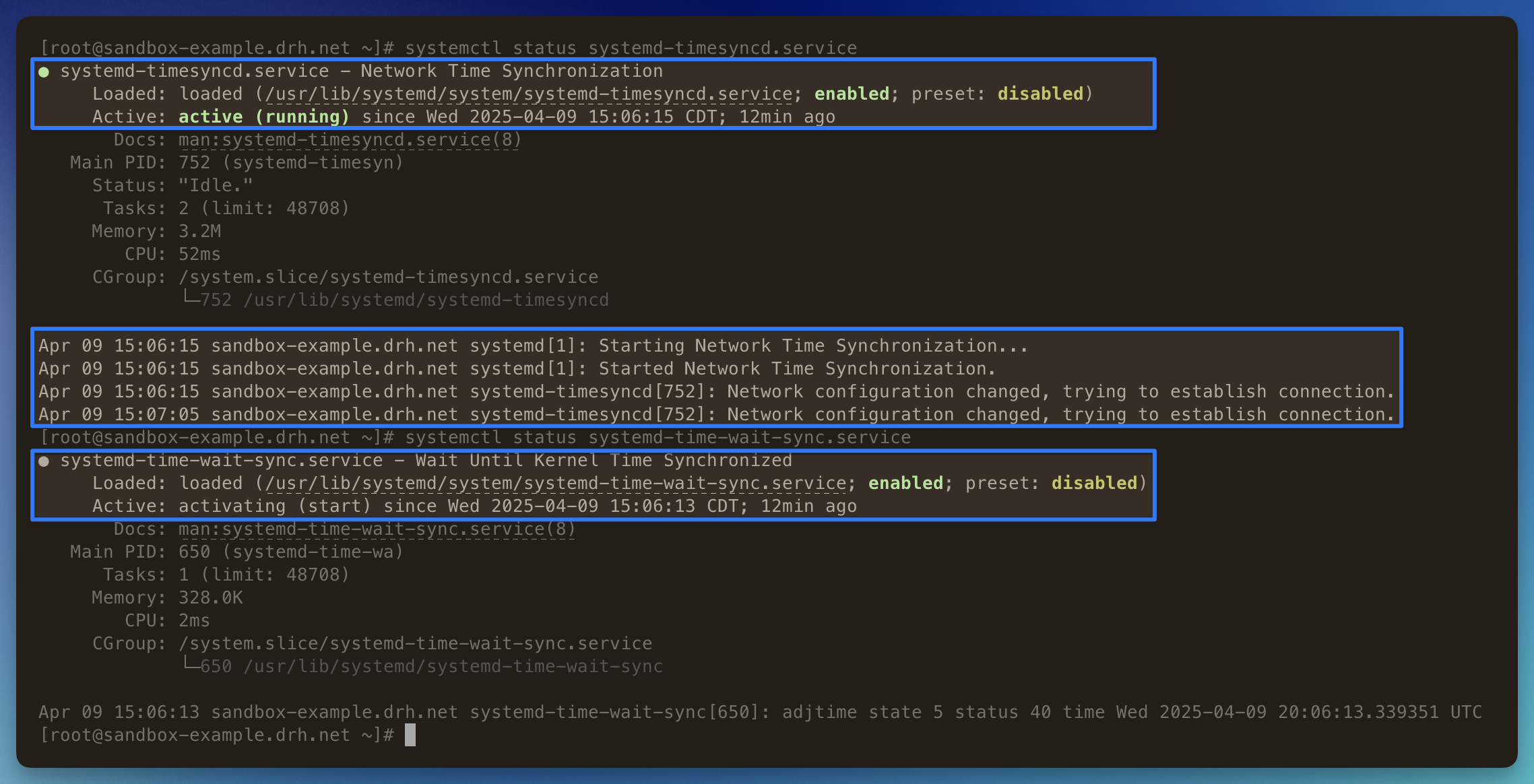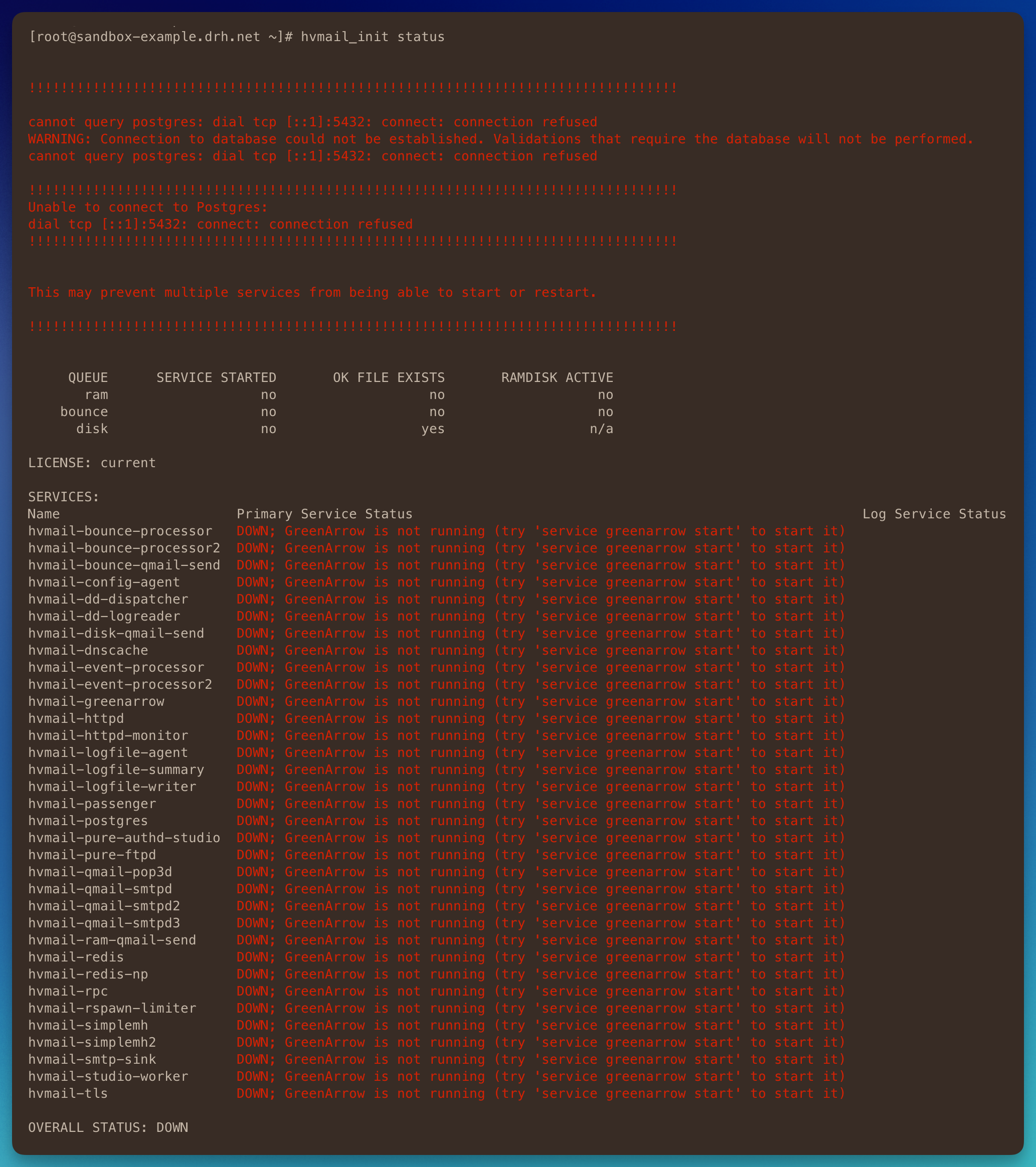Time Synchronization Services
GreenArrow depends on an accurate system clock to track events and logs. And it is critical for the system time to never jump forwards or backwards while GreenArrow is running. GreenArrow assumes that the system clock increases monotonically, so time jumps can cause statistics to be out of sync and some events to be lost.
Since version v4.337.0 (see changelog) GreenArrow depends on systemd-timesyncd on all distributions, and SystemD waits for time to be synchronized prior to starting GreenArrow’s processes. This eliminates a problem where systems that were slow to synchronize their clock could lead to problematic conditions within GreenArrow.
If time synchronization is not working during reboots or after installing GreenArrow, SystemD will not run GreenArrow’s processes until the time sync issue is resolved.
Although GreenArrow installs these time synchronization dependencies, sometimes additional configuration is required for time synchronization to work.
This document explains how to manually install these services, which can help identify and address issues with these services, and how to troubleshoot basic problems related to time synchronization.
- Table of Contents
- Installing and Running SystemD TimeSync Service
- Verifying Time Synchronization is Working
- Troubleshooting systemd-timesyncd
- GreenArrow Symptoms of Time Synchronization Service Problems
Installing and Running SystemD TimeSync Service
Installing this service is only recommended when upgrading GreenArrow from versions older than v4.337.0.
This is an optional step which can be skipped. However it can help identify time synchronization issues that could cause GreenArrow to stop after an upgrade from versions older than v4.337.0.
This service is available on the package systemd-timesyncd. To install it run the command for the Linux distribution on your server:
-
Debian/Ubuntu distributions:
apt-get update && apt-get -y install systemd-timesyncd -
RHEL and RHEL-based distributions:
dnf install -y systemd-timesyncd
Enable and start the service:
systemctl enable systemd-timesyncd
systemctl start systemd-timesyncd
Verify that the service started successfully:
systemctl status systemd-timesyncd.service
It should be similar to this screenshot:

If the service status is similar to the one in the screenshot, in particular it prints a successful Initial Clock synchronization then there are no more steps, you can resume upgrading or installing GreenArrow.
If the service status is very different or it seems that the system time was not synchronized continue reading.
Verifying Time Synchronization is Working
This procedure only applies to versions of GreenArrow greater than or equal to v4.337.0.
It also applies when upgrading from versions of GreenArrow previous to v4.337.0.
Run the following commands to query time synchronization status:
timedatectl status
timedatectl timesync-status
These commands should show that the system clock is synchronized, the NTP service is active, and details about the NTP server that has been contacted.
This is an example of the output printed by these commands:
# timedatectl status
Local time: Wed 2025-04-09 16:04:50 CDT
Universal time: Wed 2025-04-09 21:04:50 UTC
RTC time: Wed 2025-04-09 21:04:50
Time zone: America/Chicago (CDT, -0500)
System clock synchronized: yes
NTP service: active
RTC in local TZ: no
-------
# timedatectl timesync-status
Server: 66.85.78.80 (pool.ntp.org)
Poll interval: 34min 8s (min: 32s; max 34min 8s)
Leap: normal
Version: 4
Stratum: 2
Reference: 233B1B6C
Precision: 1us (-22)
Root distance: 28.166ms (max: 5s)
Offset: -1.298ms
Delay: 29.779ms
Jitter: 4.369ms
Packet count: 59
Frequency: +11.716ppm
When the timesync service can’t reach an NTP server timesync-status’s output may be slightly different, similar to the output below:
# timedatectl timesync-status
Server: 144.202.41.38 (pool.ntp.org)
Poll interval: 17min 4s (min: 32s; max 34min 8s)
Packet count: 0
Note that the packet count line is 0 and the poll interval is quite long. It hasn’t received any packets from the NTP server.
If time synchronization is not working you will need to troubleshoot time synchronization before installing, rebooting, or upgrading GreenArrow.
Troubleshooting systemd-timesyncd
Run the following commands to check the status of systemd-timesyncd and systemd-time-wait-sync services:
systemctl status systemd-timesyncd.service
systemctl status systemd-time-wait-sync.service
The screenshot below shows the output on a server where NTP is not allowed, highlighting relevant lines:

-
The Active status for
systemd-timesyncdis “active (running)”, which is the expected status. However the last lines show that the service is still trying to establish a connection to the NTP server. No indication of an NTP server contacted or of a synchronized clock. -
The Active status for
systemd-time-wait-syncis “activating (start)”, and it has been in this status for 12 minutes. This is a system service that delays the start of units that are ordered after time-sync.target until the system time has been synchronized with an accurate remote reference time source. When the system time has sync’ed the service Active status will change to “active (exited)”.
The systemd-timesyncd service will keep trying to reach an NTP server, until it does it won’t signal the systemd-time-wait-sync service.
Find out and resolve any issues preventing your system from reaching NTP servers. For example NTP traffic could be blocked by a firewall or specific NTP servers should be used for time synchronzation.
Changing systemd-timesyncd NTP servers and other options
To change the systemd-timesyncd service settings edit the /etc/systemd/timesyncd.conf file. See the man page for timesyncd.conf for more details about settings available in this file.
The configuration file on our example sandbox looks like this (removing comment lines):
[Time]
NTP=pool.ntp.org
And this configuration fetches time from NTP server 10.10.15.123:
[Time]
NTP=10.10.15.123
See the man page for timesyncd.conf for reference.
After making changes to the configuration file reload or restart systemd-timesyncd.service and systemd-time-wait-sync.service and check their status.
This screenshot shows an example of systemd-timesyncd that successfully synchronized.

GreenArrow Symptoms of Time Synchronization Service Problems
GreenArrow’s SystemD service depends on systemd-timesyncd.service and systemd-time-wait-sync.service. This means that GreenArrow’s service will wait until the server’s time has been synchronized before starting its processes.
If the server can’t reach an NTP service to sync its clock then the systemd-time-wait-sync service will wait indefinitely preventing GreenArrow’s process from starting up.
A symptom of an GreenArrow waiting for time synchronization is that hvmail_init status can’t connect to the database and all of its “services” appear down.
As in this screenshot:

When this is the problem, systemctl status greenarrow.service will print that the service was “loaded”, however, the Active line will print “inactive (dead)”, as in the screenshot below:

This error can happen if time synchronization fails when installing or upgrading GreenArrow, or during reboots.
For example, we have seen this error on environments where custom/local NTP servers were used and permissions were changed preventing NTP access from the server running GreenArrow. Time synchronization gets stuck on the next boot and GreenArrow can’t start.
